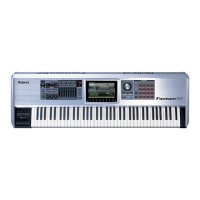
Do you have a question about the Roland Fantom-G Series and is the answer not in the manual?
| Polyphony | 128 voices |
|---|---|
| Arpeggiator | Yes |
| Expansion Slots | 2 ARX expansion slots |
| Keyboard | 88 keys (Fantom-G8), 76 keys (Fantom-G7), 61 keys (Fantom-G6) |
| Preset Patches | Over 1, 500 |
| Effects | Multi-effects, reverb, chorus, mastering effects |
| Sequencer | 16-track MIDI sequencer |
| Display | 8.5-inch color LCD |
| USB | USB (MIDI/Audio/Storage) |
| Sampling | Yes |
| Controllers | Pitch bend/modulation lever |
| Audio Inputs | 2 x 1/4" (L/Mono, R) |
| Audio Outputs | 4 x 1/4" (L/Mono, R, Assignable 1, Assignable 2), 1 x 1/4" (Headphones) |
| MIDI | In, Out, Thru |
| Storage | USB Flash Memory |
| Connectivity | USB, MIDI, Audio In/Out |
Provides an overview of the Fantom-G series and the purpose of these booklets.
Explains manual symbols, interaction methods, and the hot link feature.
Introduces the concept of realtime control and its tactile manipulation of sounds.
Details the two essential elements for realtime control: the controller and the controlled item.
Introduces physical controls like knobs, sliders, and the pitch bend/modulation lever.
Details the S1/S2 switches, D Beam sensor, and various foot pedal controls.
Explains how to program patch parameters to respond to realtime controllers.
Details how to set up PFX parameters for realtime control, similar to patch control.
Guides users through the Control Setting screen for configuring controllers.
Explains how system parameters manage controller behavior across live/studio sets.
Details the assignment and behavior options for knobs, sliders, and S1/S2 switches.
Guides on setting up the D Beam for various modes and configuring foot pedals.
Explains how to set up and configure the hold pedal for sustain.
Details System Controls for simultaneously changing multiple sound parameters.